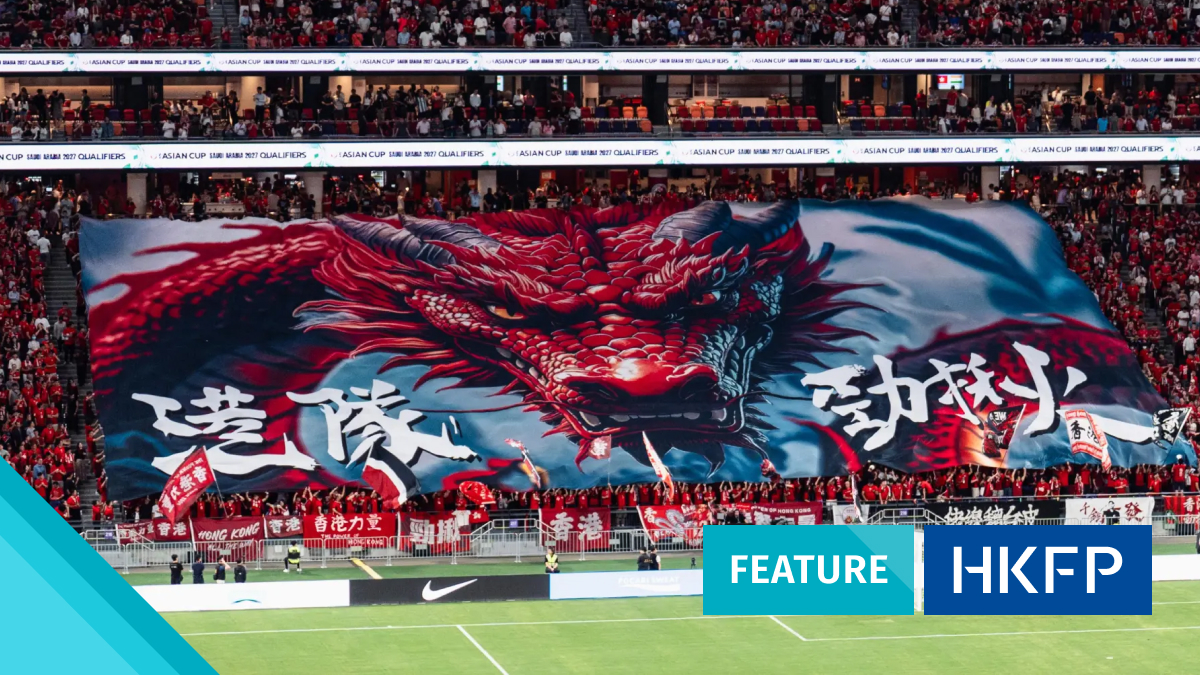Just three minutes before the start of the Hong Kong football team’s inaugural match at Kai Tak Stadium on June 10, a 40-metre-long banner featuring a fierce dragon and four Chinese characters – which translated as “Hong Kong team kick ass” – was unfurled above a sea of red-clad fans in the North Stand.
Spread out with the help of spectators, the banner covered around 4,000 seats in the arena that was packed with more than 40,000 fans. The red dragon fixed its gaze on the pitch as the home team posed for a group photo ahead of their AFC Asian Cup 2027 qualifier against India.
It was the largest tifo – banner held up during a match – ever prepared by local football fans in collaboration with the Hong Kong Football Association (HKFA).
Kept secret from the players and most spectators, the striking visual display was intended to “astound” the opponent and boost the morale of the home team, coordinator Ng Cheuk-hang told HKFP.
Brazilian-born Stefan Pereira netted a stoppage-time penalty to seal Hong Kong’s 1-0 triumph over India.
Ng, 30, is a core member of The Power of Hong Kong (TPO), a football fans group founded in 2004 with supporters dedicating themselves to cheering on the Hong Kong team in both local and international matches. So far, the group has travelled to more than 20 countries and regions to show its support.
Prior to the stunning success of the red dragon banner, Ng and other devoted fans had organised smaller-scale tifos using coloured placards and small flags. The display at Kai Tak required more complex preparation and coordination, Ng said, with the HKFA stepping in to cover the cost and enlisting another fan group, called Chi Sin Lo, to recruit helpers.

As it was their first attempt at showcasing a massive display, Ng said they had to carefully select the fabric to ensure it was not opaque – otherwise, spectators underneath might panic, not knowing what was happening.
The idea for the banner was finalised just a few days before the match, leaving them no time to rehearse the unfurling. Instead, they relied on around 40 recruited helpers to think on their feet and respond to any unexpected situations, he said.
“Compared with tifos we’ve seen elsewhere, what we did was just at a beginner’s level,” Ng said in Cantonese. “But with this experience, maybe we can try something new next time – we can be more creative.”
Tifo – derived from the Italian word tifosi, which means fans or supporters – is part of the football culture known as the ultras – the passionate, and sometimes radical, football fans who go to great lengths to support their teams. (The word ultra means “beyond,” and the term too first originated in Italy.)
The spectacular visual display often incorporates cultural elements representing the team, its country, or city.
Ng said the dragon design was inspired by the HKFA’s logo, while the phrase “Hong Kong team kick ass” came from a placard held by Hong Kong fans at the old Kai Tak Airport in 1985, when the city’s team returned home following a historic victory against China in a World Cup qualifier.


It was especially meaningful for local fans to chant and display the phrase at Kai Tak Stadium 40 years later, Ng said.
Chester Cheung, one of the founding members of Chi Sin Lo – a Cantonese phrase meaning ”crazy man” – told HKFP that the fervent atmosphere at Kai Tak could hopefully inspire some spectators to become regular supporters of the Hong Kong team.
Cheung, 28, began supporting local football in 2015. He said people around him had questioned the quality of Hong Kong football, describing it as “very amateur” and saying the city’s representative team was “no match” for others in international tournaments.
But what has kept Cheung a diehard fan for almost a decade is the unique sense of closeness he feels with local players – something he feels is very different from supporting a foreign team.
The match that made Cheung fall in love with the city’s team was the World Cup qualifier between Hong Kong and China on November 17, 2015. He joined forces with fans he had met on online forums to create passionate chants, shouting at the top of their lungs.

The intense, sold-out match at Mong Kok Stadium ended in a 0-0 draw, but it marked the beginning of Chi Sin Lo – a fervent, unconventional fan group devoted to supporting Hong Kong’s football team.
“After the Hong Kong team match, I realised how genuine the connection between me and the players was. I used to support Chelsea in the Premier League, but I had never experienced anything like this before,” Cheung said.
Ng echoed that the close connection between players and fans is what makes Hong Kong football feel more “touchable.”
He has sought to promote more interaction among stakeholders in the local football scene, such as organising matches for supporters of different Hong Kong Premier League teams.
A journalism graduate, Ng also runs a blog called OneTwo.hk, where he documents stories related to the sport and publishes profile interviews with players, coaches, and others involved in the game.


Hong Kong football fans should not underestimate the impact they may have on the sport, Ng said. Instead of simply criticising the problems in the city’s football development, people should consider how they can get involved and help drive improvements, he added.
Before every home match held in Hong Kong, Cheung, Ng, and some key members of the fan clubs arrive at the venue about two hours early to set up decorations and displays. They usually bring a suitcase packed with banners, flags, and loud hailers for chanting slogans.
Everything they plan to display must be approved in advance by the HKFA and the venue operator.

In its early days, Chi Sin Lo members, who saw themselves as ultras, vowed to be the team’s “12th man” by putting pressure on the opposing team. They shouted profanities to keep the atmosphere intense, believing that was how true football fans should support their team.
They also didn’t hold back criticism of the team they supported, often yelling at players when they underperformed.
But after attending more matches alongside TPO – a more reserved supporter group that disapproved of swearing – Cheung said he and other Chi Sin Lo members gradually became “more moderate.”
“My mentality has changed. I believe that once the players put on the Hong Kong team jersey, we should watch and support them – no matter what,” he said, adding that the HKFA had reminded them to avoid breaching match etiquette, as it could lead to penalties.
Both Ng and Cheung observed that Hong Kong’s football fan base has grown in recent years, with more supporters travelling overseas to back the team.

They attributed the surge in interest to the rise of social media, which has helped showcase the vibrant atmosphere at matches, as well as to Hongkongers’ passion for travel. A recent match in Singapore and the upcoming East Asian Cup in South Korea have both drawn many fans eager to support the team in person.
Chi Sin Lo has also offered shuttle bus services to around 800 Hong Kong fans planning to attend the matches in a city near Seoul.
Ng and Cheung agreed that despite the growing fan base, the support has not translated into success for the local Premier League. Some football clubs are even looking to cut costs amid a sluggish economy, Ng said.
Cheung admitted that while Chi Sin Lo had previously organised activities to support local clubs, the response was underwhelming.
He said it might feel “unfair” to promote certain clubs over others, so for now, the group is focusing its efforts on supporting the Hong Kong national football team.

He is eager to expand Chi Sin Lo and has recently stepped up recruitment efforts for new volunteers. The core members who founded the group in 2015 are “getting old,” he said, and they need fresh blood to bring in new ideas and energy to support the Hong Kong football team.
Cheung said he hoped to see a fully packed stadium for the upcoming home matches. While some fans criticised those who attended the June 10 game as mere “bandwagon fans” who were just “following the trend,” Cheung said it didn’t matter. The more supporters, the better.
“I was also just following the trend back then, but I gradually became more and more invested” in Hong Kong football, he said. “You always need that first opportunity to experience it before you can truly become passionate.”
Support HKFP | Policies & Ethics | Error/typo? | Contact Us | Newsletter | Transparency & Annual Report | Apps
Help safeguard press freedom & keep HKFP free for all readers by supporting our team

Original reporting on HKFP is backed by our monthly contributors.
Almost 1,000 monthly donors make HKFP possible. Each contributes an average of HK$200/month to support our award-winning original reporting, keeping the city’s only independent English-language outlet free-to-access for all. Three reasons to join us:
- 🔎 Transparent & efficient: As a non-profit, we are externally audited each year, publishing our income/outgoings annually, as the city’s most transparent news outlet.
- 🔒 Accurate & accountable: Our reporting is governed by a comprehensive Ethics Code. We are 100% independent, and not answerable to any tycoon, mainland owners or shareholders. Check out our latest Annual Report, and help support press freedom.
- 💰 It’s fast, secure & easy: We accept most payment methods – cancel anytime, and receive a free tote bag and pen if you contribute HK$150/month or more.


